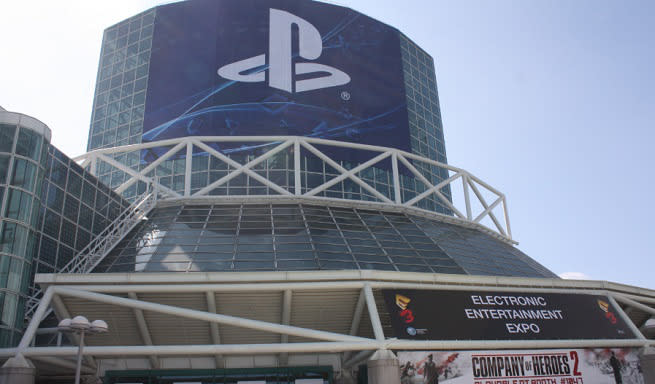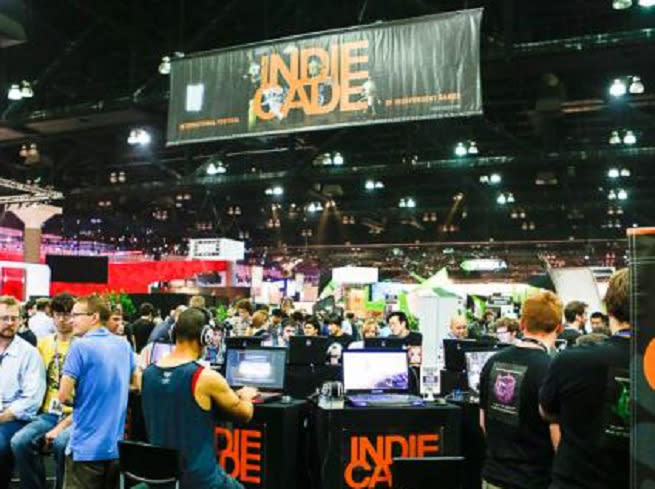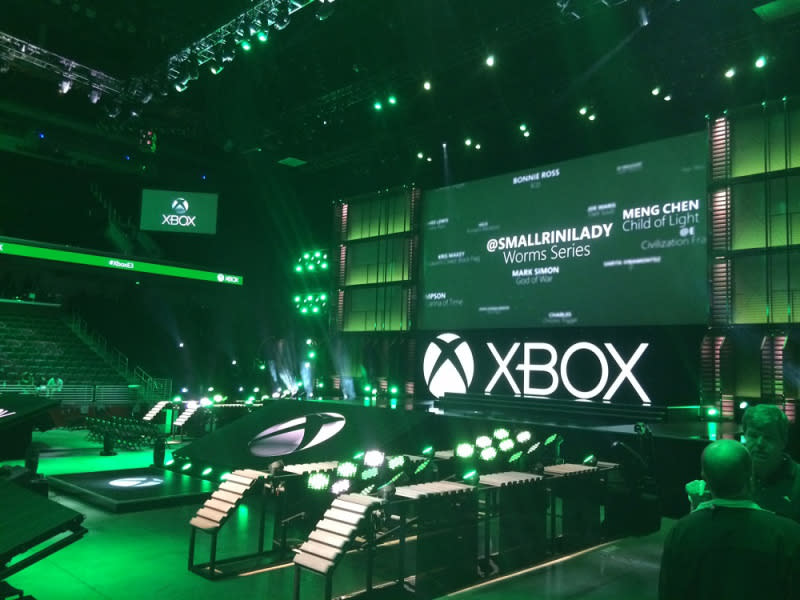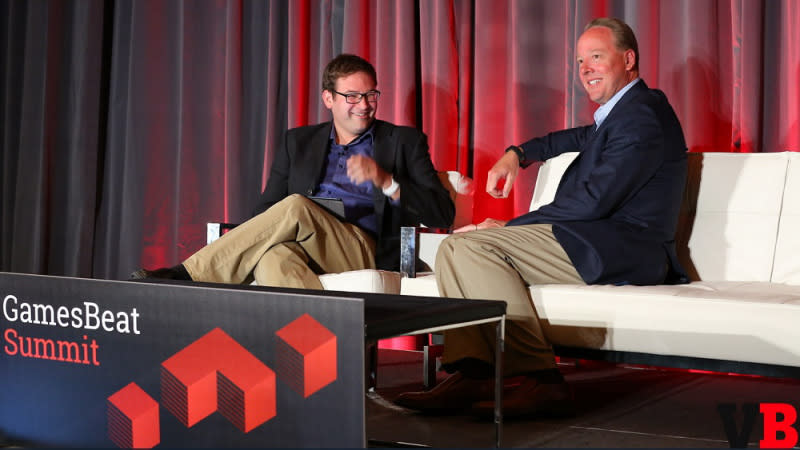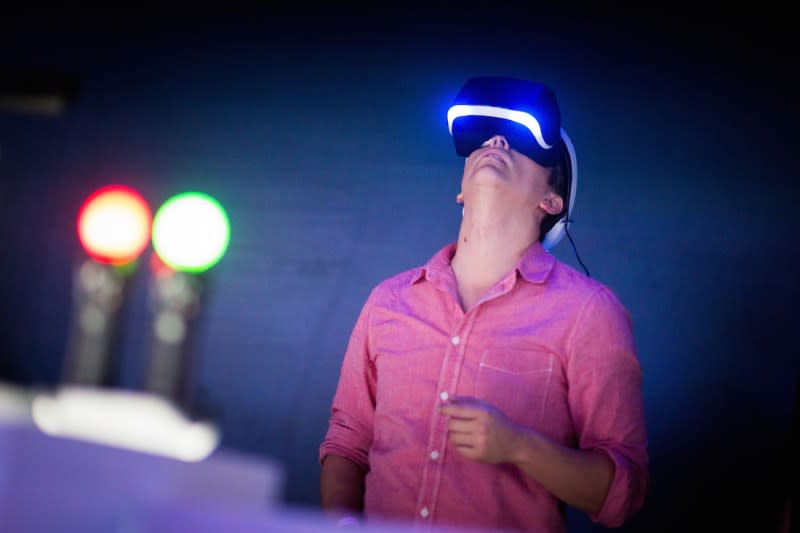E3 stretches in new directions: mobile games, VR, and 5,000 fan attendees
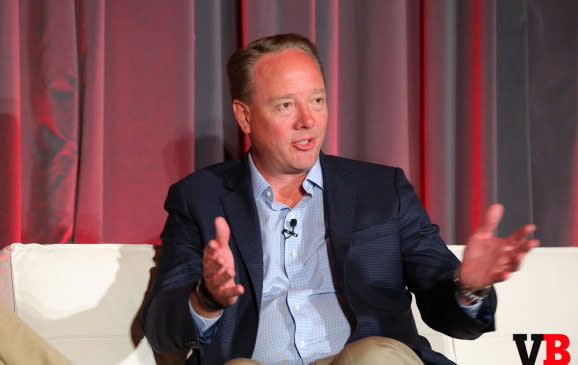
EXCLUSIVE:
The Electronic Entertainment Expo arrives the week of June 14 in Los Angeles, where 50,000 people will gather to experience the latest in gaming one of the industry’s biggest and most important trade shows of the year. Each year, we’ve interviewed Mike Gallagher, chief executive and president of the Entertainment Software Association, which puts on the event, about what’s going to be new and different.
Gallagher is the chief spokesman for the game industry, which according to market researcher Newzoo will be a $91.5 billion business by the end of 2015. He has to navigate issues ranging from video game violence to diversity in not just games themselves but the people who make them. We talked about a lot of the issues and trends in gaming in advance of the show. He also spoke at our last couple of GamesBeat events about the increasing reach of gaming and its expansion to new platforms such as virtual reality.
The interesting facts: E3 will have 50,000 attendees, including 5,000 hardcore fans who will get in for free (a first for the event); 273 companies; 350,000 square feet of exhibit space; 1,500 games; more than 100 games that have never been shown before; 22 virtual reality exhibitors; and 70 mobile gaming companies.
Gallagher said that anyone who says that games have become boring or lack creativity hasn’t been to E3. In case you want to check to see if Gallagher says the same thing every year, here’s what he said in 2014, 2013, 2012 (er, his henchman Rich Taylor), 2011, 2010, 2009 (we skipped this one), and 2008. But in any year, Gallagher always has the bird’s-eye view of what is happening in gaming.
Here’s an edited transcript of our conversation.
Above: E3 takes place at the Los Angeles Convention Center
Image Credit: Dean Takahashi
GamesBeat: Do you have some of the usual numbers for how big the show is this year?
Mike Gallagher: It’s booked from corner to corner, absolutely packed with exciting companies. A large number of them are new. We have a lot of innovation happening in the video game space. That’s why the theme of the show, “Experience the Evolution,” couldn’t be more appropriate.
Underneath that we have a couple of other interesting things. This year, for the first time, we’re allowing some of our biggest fans to be a part of the show. A select group of about 5,000 of the most enthusiastic, most social-media-connected fans have been invited to the show. That’s going to bring a unique element. It’s the strongest component of the consumer sector that will be in person at the show.
We also have great new technologies on display in a very competitive environment. It’s not just the tent-pole releases that we’re used to seeing at E3. We just saw the first tremors of that with the Fallout 4 announcement. That drew a lot of attention toward Bethesda’s briefing on Sunday and from there to the show floor. We’ll see that flow, which is certainly familiar.
But we also have VR and AR there in force. We have 22 companies, including the three leaders, that will be there showing their intentions and what they’re going to bring to the marketplace. Consistent with other technologies, like the Wii and motion-based gameplay, these new technologies and new interfaces between consumers and the games they love are going to debut at E3. Oculus was at the show last year and the year before. Morpheus was on display at PlayStation last year. This year it’s grown to 22 companies. I expect to see a lot of excitement around what those companies are announcing, plus Microsoft, which will have HoloLens there for people to try. It’s going to add a new evolutionary impact and expansion to the show.
We have more than 70 companies in the mobile space coming to E3. That’s a high water mark for us. We’ve always said that the industry’s premier trade show is open to all comers. We’re seeing the broadest acceptance yet by the mobile community this year.
GamesBeat: Do you know what attendance is targeting?
Gallagher: It’ll be a little higher this year. We have some obvious limitations on that and we control carefully for them. Since we brought the show back in the bigger format, the successful format we’ve seen since 2009, we’ve targeted between 45,000 and 50,000. We’ve hit that range every year. This year I’d expect it to be a little higher, but not much. We’re metering the consumer element in the building in a very qualified way, making sure we have a very energized and exciting consumer participation, but it’s not going to blow out the numbers. You’ll see just north of 50,000. That’ll maintain the production level and the quality of the experience for attendees.
Above: IndieCade at E3 2013
Image Credit: GamesBeat
GamesBeat: Are those consumers paying an attendance fee?
Gallagher: No, those consumers I’m speaking of will be coming in for free. It’s the Willy Wonka golden ticket coming to E3.
GamesBeat: How much exhibit space and how many companies altogether are there this year?
Gallagher: We have 273 exhibitors total this year, which is up from last year, when I think we had 220. It’s a pretty big group. We have north of 350,000 square feet, including the suites. Every square foot of the L.A. Convention Center is full and there’s a lot of activity in the adjacent hotel ballrooms. You can’t get a hotel room. You can’t book a meeting room. It’s all full.
GamesBeat: There are still people who generally are skeptical of E3. They feel like it’s not the place for creativity. I’m not sure where they go for that, but it’s the same criticism people have of Hollywood — it’s blockbusters, it’s sequels, it’s not about games that are inspiring because of their creativity.
Gallagher: Those people have clearly not been to E3. When you walk in the building on Tuesday, it’s immediately apparent that you’re in one of the most creative environments on earth. It’s high tech. It’s immersive. It’s interactive. It’s not linear, like music or motion pictures. It’s get your hands on it, experience, and be a part of it. That’s unique to video games and it’s on display to the maximum degree at E3.
We have 273 companies that are filling 350,000 square feet and generating, in the last two years, more than 50 billion media impressions at the show. That’s creativity. It’s an incredible connection to those enthusiasts who want to enjoy the industry. Keep in mind, there’s only 7 billion people in the world and only 2.5 billion of them have internet access. That creativity is resonating directly with everyone who’s on the internet and enjoys video games.
The truth of the matter is shown in those numbers, in the sold-out show, in the engagement level we have. Just look at the medium itself. Twitch now has 100 million unique viewers per month on its website. That’s creative. That’s high energy. We have 1,500 new titles and products on display at E3. More than 100 of those haven’t been revealed yet to anybody.
Above: Microsoft’s setup for its E3 2014 press briefing.
Image Credit: Dean Takahashi/GamesBeat
GamesBeat: On the level of creativity the game industry needs, there’s being creative with original IP and new platforms, but there’s also being creative with Call of Duty every year. I wonder what your thoughts are on what that balance should be like in order for the industry to keep growing.
Gallagher: Just because there’s a sequel to a game doesn’t mean you can’t use the word creative alongside it. There are innovations in gameplay in storytelling done in sequels that are remarkable. The degree of excitement around the next Call of Duty, the next Last of Us, or any similar game, whether it’s FIFA or Madden—The enthusiasts who support those games love the innovations that come in the gameplay. There’s definitely creativity in those titles. Anybody who’s played them or made them knows that. That’s why they’re blockbusters year after year.
Looking beyond the blockbusters, our industry has never had more indie development than it does today. If you look at PlayStation’s press briefing last year, where they had the arc of independent game developers on stage–The indie developer has an incredible runway in front of them. We have the IndieCade exhibit at E3. We’ll have a number of companies making their voices heard. Others will partner with publishers, like they did last year with PlayStation. All of that lives and thrives within E3.
Remember Red Dead Redemption, a hugely successful new IP. Remember BioShock. When that was first made people questioned the premise, but it became a massive hit. You do have innovation in storytelling and in new IP. You see it every year at E3.
GamesBeat: Are we going to see this creativity in Las Vegas soon, instead of Los Angeles?
Gallagher: That’s not happening any time soon. I think you’re happy about that.
GamesBeat: Los Angeles is your home for a while yet?
Gallagher: We’ll have more to say about that, but certainly for this show, it’s Los Angeles. The next one will be in Los Angeles. Look for a bit more news from us in the near future about what’s going to be happening next on that front.
GamesBeat: Any personal favorites you’re looking forward to?
Gallagher: I go into the show excited about the whole of it, how innovative and how much fun the games they are, how compelling the storylines can be. For this year, just from what I know, I’m fascinated with a few things. The Last of Us was the best video game I ever played. I was so impressed with the gameplay and storyline. I’m looking forward to seeing the sequel. The Division, which Ubi previewed last year, looked fantastic. I’m sure we’ll have more to see there. Just the release of the trailer for Fallout 4 shows what a powerful and creative company Bethesda can be. Star Wars Battlefront, that has all the potential in the world to be a smash hit, especially coming out close to the new motion picture. Halo 5, if I think of the first memorable games on a platform, Halo was certainly that for the Xbox. Halo 5 is right at the top of the list.
I’ve already scheduled my own demos to make sure I’m seeing and experiencing everything, so I’m looking forward to VR and AR, finding out how those segments have matured over the past year. There’s so much buzz and excitement. The idea that the technology could be used not only for great video games, but that it could be a $150 billion industry by itself—I think Digi Capital said it could happen within five years? It’s fantastic that they’re making their debuts, refining their technology, and making their connections with the public through E3.
Above: Ian Sherr of Cnet and Mike Gallagher of the ESA at GamesBeat Summit.
Image Credit: Michael O'Donnell/VentureBeat
GamesBeat: We’ve had a lot of discussions about inclusiveness and diversity over the past year. Do you feel like that’s going to be in evidence at E3.
Gallagher: You’ll see examples of the diversity of the industry on display for the whole world to see. When it comes to diversity on an international base, 40 percent of the exhibitors are international companies. When you look at where these products come from and who they’re for, it’s everyone in the world.
When it comes to gender issues, I spoke about this with you at your conference. We see the trajectory for the games industry as very bright. In 2009, according to IGDA, nine percent of the industry were women. According to the same source today, that number is 22 percent. The Higher Education Video Game Alliance, 63 universities with programs that teach video games or have video game degree programs, they’ve said that their video game programs have proportionally twice the representation of women compared to computer science and engineering at 34 percent.
The industry is on a path to an even greater number of women engaged in making games and growing the industry. Women are already playing games, we know that. 44 percent of gamers are women. You’ll see those numbers pull quite a ways ahead of the rest of the tech industry. It’s because we’re a creative medium. You’ll see that on the floor at E3. We’re proud of where the industry is going in that respect.
GamesBeat: Intel is poised to do a lot of investment in diversity in gaming and tech. Do you have any observations about them in particular?
Gallagher: They’re going to need to, to keep up with us.
GamesBeat: Do you have any other topics in your mind? I know you have your education event again.
Gallagher: We’re very proud of this one. We’re now on to our sixth annual Games for Learning Summit. Seven years ago, people would have said these subjects would never cross. The excitement is very high. We have Richard Culotta. He was the leader of the Games for Change summit, the partnership we did with the Department of Education. Greg Toppo will be speaking. His book (The Game Believes in You) is receiving a lot of very positive attention. Laurent Detoc, the president of Ubisoft and a board member, he’ll be speaking. We have Mike Strautmanis from Disney, formerly of the Obama White House. We’ll have a senior vice president from the Boys’ and Girls’ Club, Julie Teer. We have great speakers.
One thing I like about the topics: nobody is allowed to talk about white papers. Nobody can talk about conferences. The only thing we’re allowed to focus on at this event, going from 9:30 until 2:00, is doing. Where are games going to be used? How are they going to be used effectively? How are they going to deliver results that will help us close our education gap in this country? That’s the only thing that everyone in this gathering will talk about. Next year, we can get together and report on everything that moved the needle. We’re not into theory here. We’re into getting it done. It’s a great conference.
There’ll be the usual parade of after-hours events. I doubt I’ll be back to my hotel much before 2 in the morning any given night. That’s the way it should be. It’s a sign of a healthy E3.
Above: Project Morpheus E3 2014 by Rich Prugh
Image Credit: Rich Prugh/GamesBeat

